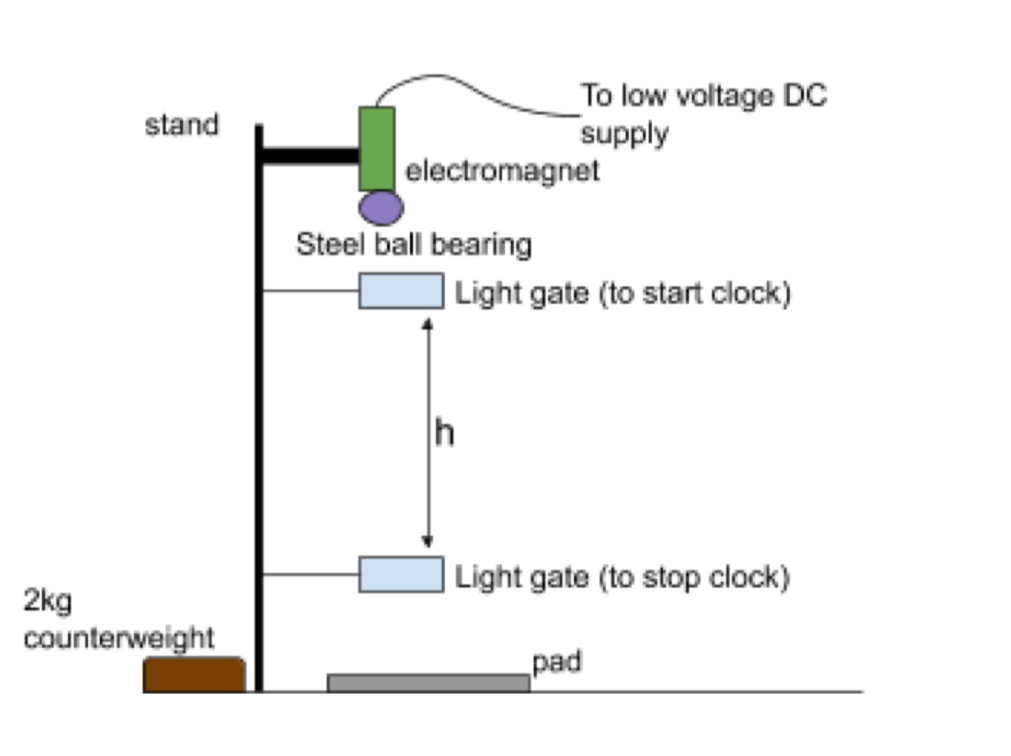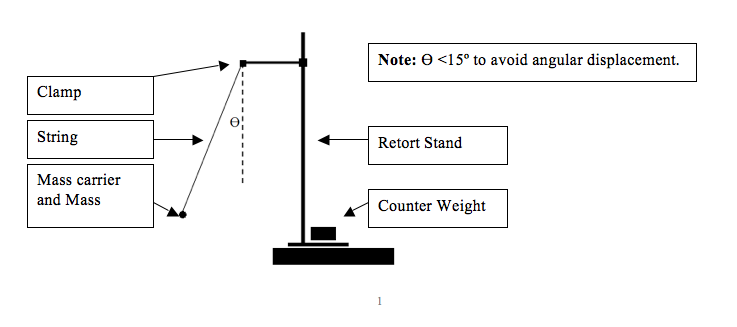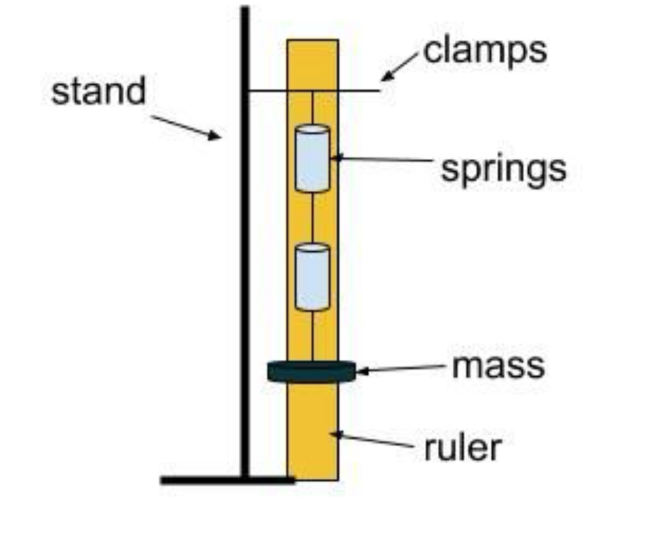Module 1 - Development of practical skills in physics
1/6
Earn XP
Description and Tags
Name | Mastery | Learn | Test | Matching | Spaced |
|---|
No study sessions yet.
7 Terms

Question 1: Freefall Method for determining g.
In a freefall experiment, a ball is dropped from rest, and the time taken for it to fall a known distance is measured. Describe how this experiment can be conducted to determine the value of g, including the apparatus used, the method of taking measurements, and how the value of g can be calculated from the results.
In your answer, include:
A clear description of the setup and any precautions taken to ensure accurate measurements.
A discussion of the sources of uncertainty in the experiment and how they could be minimized.
How the value of g is determined using the equation of motion.
Model Answer for Freefall Method to Determine g
In this experiment, the value of g (acceleration due to gravity) is determined by measuring the time an object takes to fall from a known height.
Apparatus:
Electromagnet to hold and release the object.
Metal ball as the falling object.
Timer (automatically triggered by a light gate or pressure pad).
Meter ruler for measuring height.
Clamp stand to secure the apparatus.
Method:
Set up the apparatus so the ball is held at a known height, hh, above the light gate or pad. Measure hh from the bottom of the ball to the detection point.
Measure hh using a meter ruler with millimeter precision. Take multiple readings and calculate an average height.
Release the ball from rest using the electromagnet, and record the time, tt, for the ball to reach the bottom. The timer stops automatically via the light gate or pad.
Repeat the experiment for at least five different heights, taking multiple time measurements for each height, and calculate an average time.
Calculation of g:
Using the SUVAT equation:
h = 1/2gt²
rearrange to find g:
g = 2h/t²
For each trial, calculate g and take an average from all trials.
Sources of Uncertainty:
Measurement of height: Minimize parallax error by aligning the ruler vertically.
Timing: Automatic timing reduces human reaction error.
Air resistance: Typically negligible but could slightly reduce the calculated gg.
Release mechanism: Ensure a smooth, friction-free release with the electromagnet.
Improvements:
Use more precise instruments (e.g., digital calipers) for height.
Repeat measurements to reduce random error.
If possible, conduct the experiment in a vacuum to eliminate air resistance.

Question 2: Pendulum Method for Determining g
In a pendulum experiment, the time period of oscillations is measured to calculate the acceleration due to gravity, g. Describe how this experiment can be conducted, detailing the apparatus used, the method of taking measurements, and how the value of g can be determined from the results.
In your answer, include:
A clear description of the setup, how to measure the time period of oscillations, and how the length of the pendulum is determined.
A discussion of sources of error and how accuracy can be improved in the experiment.
How the value of g is calculated using the relationship between time period and length of the pendulum.
Model Answer for Pendulum Method to Determine gg
In this experiment, the value of gg is determined by measuring the time period of a simple pendulum and using the relationship between the pendulum's length and its period.
Apparatus:
String and bob to create the pendulum.
Stopwatch for timing the oscillations.
Meter ruler to measure the length of the pendulum.
Clamp stand to secure the pendulum.
Method:
Set up the pendulum with a string of known length, L, measured from the point of suspension to the center of the bob. Use a meter ruler to measure L precisely.
Displace the pendulum by a small angle (less than 15°) and release it to start simple harmonic motion. Start the stopwatch when the pendulum passes through its equilibrium position.
Measure the time for 10 complete oscillations to reduce error, then divide by 10 to get the time period, T, for one oscillation. Repeat the process and take an average T.
Repeat the experiment for different lengths of the pendulum, recording the time period for each length.
Calculation of g:
The time period T of a simple pendulum is given by:
T = 2pie root(L/g)
Rearranging for g:
G = 4pie²L/T²
For each length L, calculate gg and take an average of the results.
Sources of Uncertainty:
Measurement of length: Use a precise meter ruler and ensure the string is straight and taut.
Timing errors: Measure the time for multiple oscillations to reduce reaction time errors. Use a consistent starting and stopping point for the stopwatch.
Small angle approximation: Ensure the displacement angle is small to satisfy simple harmonic motion assumptions.
Improvements:
Use a light gate to automate timing and reduce human error.
Repeat measurements for each length and average the results to reduce random error.
Use a rigid support to minimise sway in the pendulum.

Determining Terminal Velocity:
You are provided with a small spherical object (such as a ball bearing) and a tall, clear liquid column. Describe how you would conduct an experiment to determine the terminal velocity of the object as it falls through the liquid. In your answer, include:
The apparatus required,
A detailed method of how you would collect the necessary data,
How you would process the data to determine the terminal velocity,
Any precautions or considerations to ensure the accuracy of your results.
Model Answer:
To determine the terminal velocity of a small spherical object falling through a liquid, the following method can be used:
Apparatus:
A tall transparent cylinder (e.g., measuring cylinder) filled with a viscous liquid (e.g., glycerol or oil)
Small spherical object (e.g., ball bearing)
Ruler or marked scale on the cylinder
Stopwatch
Tongs or tweezers for handling the object
Thermometer to measure the liquid temperature
Retort stand and clamp to secure the cylinder
Method:
Set Up the Apparatus: Secure the transparent cylinder vertically using a retort stand and clamp. Ensure the liquid is at a stable temperature, and measure the height of the liquid column.
Release the Object: Using tongs or tweezers, gently release the spherical object from rest near the top of the liquid column, ensuring it falls straight down the center.
Timing the Fall: As the object falls, use the ruler or scale marked on the cylinder to observe when it has reached a constant speed (i.e., terminal velocity). This can be identified by the object covering equal distances in equal time intervals.
Measure the Time for a Known Distance: Start a stopwatch as the object passes a specific point on the cylinder (when it is moving at constant speed) and stop the stopwatch when it reaches another marked point further down. Measure the distance between these points using the scale on the cylinder.
Repeat: Repeat the procedure at least 3 times for consistency and average the times to improve accuracy.
Data Processing:
Calculate Terminal Velocity: Once the object has reached terminal velocity (constant speed), you can calculate this by dividing the distance between the two points by the average time taken to travel that distance:
Vt = distance/ time
where vt is the terminal velocity, the distance is the known distance between the two points, and time is the average time from multiple trials.
Precautions for Accuracy:
Temperature Control: Measure the temperature of the liquid with a thermometer to ensure that the viscosity of the liquid remains constant, as viscosity changes with temperature.
Minimize Parallax Error: When reading the distance or timing the object, ensure your eye is level with the markings on the cylinder to avoid parallax errors.
Release Method: Ensure the object is released gently without any initial velocity to avoid affecting the results.
Sufficient Time for Terminal Velocity: Allow the object to fall far enough to ensure it reaches terminal velocity before timing its descent.
By following this method, the terminal velocity of the object can be accurately determined.

Investigating initial velocity and stopping distance.
You are provided with a small toy car, a ramp, a ruler, and a stopwatch. The car is released from rest at different heights on the ramp, and it travels along a flat surface after descending the ramp. You are tasked with investigating how the initial speed of the car affects its stopping distance on the flat surface.
Describe an experiment that you could conduct to investigate the relationship between the initial speed of the car and its stopping distance. In your answer, you should:
Identify the variables you would control, change, and measure.
Explain how you would determine the initial speed of the car after it leaves the ramp.
Describe how you would measure the stopping distance.
Outline any steps you would take to ensure the accuracy and reliability of your results.
Include any safety precautions that should be considered during the experiment.
To investigate how initial speed affects stopping distance, I would use the following method:
Variables:
Independent variable: Initial speed of the car (determined by the height of release on the ramp).
Dependent variable: Stopping distance on the flat surface.
Control variables: Surface type, car mass, and angle of the ramp.
Method:
Release the car from different heights on the ramp to vary its initial speed.
Measure the height from which the car is released using a ruler. Use kinematic equations to calculate initial speed. The initial speed vv at the base of the ramp can be determined using v=2gh, where h is the height and g is the acceleration due to gravity.
Measuring Stopping Distance:
Once the car reaches the flat surface, use a ruler to measure the distance from the point it leaves the ramp to where it comes to rest.
Accuracy and Reliability:
Repeat each trial 3 times for each height and calculate the average stopping distance to improve reliability.
Ensure consistent ramp angle and minimize frictional variations by using the same surface for all trials.
Safety:
Ensure the ramp is stable to prevent it from collapsing.
Avoid standing directly in the car's path.

Determining the Young’s modulus of a metal.
You are provided with a metal wire, a set of weights, a clamp stand, a meter ruler, and a micrometer screw gauge. Your task is to determine the Young modulus of the metal wire.
Describe how you would conduct an experiment to determine the Young modulus of the wire. In your answer, you should:
Identify the quantities you need to measure and explain how you would measure them.
Explain how you would ensure accurate and reliable measurements for each quantity.
Describe how you would calculate the Young modulus from your data.
Discuss any potential sources of error and how you would minimize them.
Outline any safety precautions you would take when carrying out the experiment.
To determine the Young modulus of the metal wire, I would follow this procedure:
Apparatus and Setup:
Apparatus: Metal wire, clamp stand, micrometer screw gauge, weights, meter ruler, and a measuring scale (or a caliper).
Setup: Secure the metal wire horizontally using the clamp stand at one end. The wire should be taut and horizontal, and the other end should be attached to a set of known weights.
Measuring the Diameter of the Wire:
Use a micrometer screw gauge to measure the diameter of the wire. Take several measurements at different points along the length of the wire and calculate the average diameter to ensure accuracy.
This is crucial because the cross-sectional area of the wire is used to calculate the force acting on it.
Measuring the Extension of the Wire:
Measure the original length of the wire using the meter ruler.
Attach a known weight to the wire and measure the extension of the wire using the meter ruler. Ensure to record the change in length accurately as the weight is added.
Repeat this for multiple weights to obtain a range of forces and corresponding extensions.
Calculating the Force:
The force applied on the wire is given by the weight of the object, F=mg, where mm is the mass of the weight and gg is the acceleration due to gravity (9.8 m/s²).
Calculating the Young Modulus:
The Young modulus E can be calculated using the formula:
E=F×L/A×ΔL
Where:
F is the force applied (calculated from the weight),
L is the original length of the wire,
A is the cross-sectional area of the wire (calculated from the diameter),
ΔL is the extension of the wire for each applied force.
Use the data for force and extension to plot a graph of force against extension, and calculate the slope of the linear part of the graph. The Young modulus is related to the slope, and this allows you to calculate it accurately.
Accuracy and Reliability:
To ensure accurate measurements, use a micrometer screw gauge for precise measurements of the wire's diameter and take multiple readings for both the diameter and the extension to calculate averages.
Use a stable clamp stand to keep the wire taut and prevent any movement, which could affect the extension measurement.
Use a vernier scale or caliper to measure the extension of the wire accurately.
Make sure the weight is added slowly to avoid any shock loading, which could affect the results.
Minimizing Errors:
Ensure the wire is free from kinks or bends, as these could introduce errors in extension measurements.
Make sure the weights are hanging vertically and that the wire is straight to avoid any lateral forces.
Account for any potential temperature variations, as this could affect the wire's elasticity.
Safety Precautions:
When using weights, make sure they are securely attached to the wire to avoid any accidents.
Ensure the wire is clamped securely to prevent it from snapping under tension.
Handle the weights carefully to avoid injury.

Investigating springs in series and parallel.
You are investigating the effect of connecting springs in parallel and series on their spring constant. You have a set of identical springs, a ruler, a set of known masses, and a spring scale. You are tasked with determining how the arrangement of springs affects their overall spring constant.
Describe an experiment to investigate the effect of connecting springs in series and parallel on the total spring constant. In your answer, you should:
Identify the variables you would control, change, and measure.
Explain how you would measure the extension of the springs when a known mass is applied.
Describe how you would calculate the spring constant in both series and parallel arrangements.
Outline any steps you would take to ensure the accuracy and reliability of your results.
Include any safety precautions that should be considered during the experiment.
To investigate the effect of connecting springs in series and parallel on the total spring constant, the following experiment can be conducted:
Apparatus:
Identical springs
Set of known masses
Spring scale or ruler (for measuring extension)
Clamp stand
Weights
Method:
Variables:
Independent variable: The arrangement of springs (series or parallel).
Dependent variable: The total spring constant of the system.
Controlled variables: The mass applied, the type of springs used, and the measurement of extension.
Measuring Extension:
For each arrangement (series and parallel), attach known masses to the spring system and measure the extension using a spring scale or ruler.
Use Hooke’s Law (F=kx) to calculate the spring constant for each arrangement, where F is the force (mass × gravitational field strength), and x is the extension.
Series Arrangement:
In a series arrangement, the total spring constant ktotal is found by:
1/ktotal = 1/k1 + 1/k2 + …
Parallel Arrangement:
In a parallel arrangement, the total spring constant ktotalktotal is found by:
ktotal = k1 + k2 + …
Ensuring Accuracy:
Use a range of known masses to ensure reliable results.
Repeat measurements to reduce random errors.
Ensure that the springs are not stretched beyond their elastic limit to maintain Hooke's Law validity.
Safety Precautions:
Ensure the setup is stable to prevent the springs from snapping.
Wear safety glasses to protect eyes in case a spring breaks under load.
Investigating the property of plastic.
You are provided with a plastic ruler, a set of weights, a ruler, and a clamp stand. Your task is to investigate how the force applied to a plastic ruler affects its extension (stretching).
Describe an experiment to investigate the relationship between the force applied and the extension of the plastic ruler. In your answer, you should:
Identify the variables you would control, change, and measure.
Explain how you would apply different forces to the ruler and how you would measure the extension.
Describe how you would ensure the accuracy and consistency of your measurements.
Explain how you would determine when the plastic ruler starts to deform permanently (if applicable).
Outline any safety precautions that should be considered during the experiment.